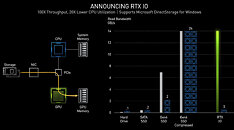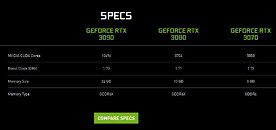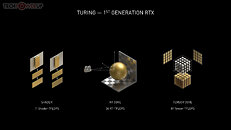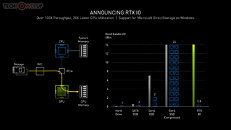Wednesday, September 2nd 2020

NVIDIA Announces GeForce Ampere RTX 3000 Series Graphics Cards: Over 10000 CUDA Cores
NVIDIA just announced its new generation GeForce "Ampere" graphics card series. The company is taking a top-to-down approach with this generation, much like "Turing," by launching its two top-end products, the GeForce RTX 3090 24 GB, and the GeForce RTX 3080 10 GB graphics cards. Both cards are based on the 8 nm "GA102" silicon. Join us as we live blog the pre-recorded stream by NVIDIA, hosted by CEO Jen-Hsun Huang.Update 16:04 UTC: Fortnite gets RTX support. NVIDIA demoed an upcoming update to Fortnite that adds DLSS 2.0, ambient occlusion, and ray-traced shadows and reflections. Coming soon.Update 16:06 UTC: NVIDIA Reflex technology works to reduce e-sports game latency. Without elaborating, NVIDIA spoke of a feature that works to reduce input and display latencies "by up to 50%". The first supported games will be Valorant, Apex Legends, Call of Duty Warzone, Destiny 2 and Fortnite—in September.Update 16:07 UTC: Announcing NVIDIA G-SYNC eSports Displays—a 360 Hz IPS dual-driver panel that launches through various monitor partners in this fall. The display has a built-in NVIDIA Reflex precision latency analyzer.Update 16:07 UTC: NVIDIA Broadcast is a brand new app available in September that is a turnkey solution to enhance video and audio streaming taking advantage of the AI capabilities of GeForce RTX. It makes it easy to filter and improve your video, add AI-based backgrounds (static or animated), and builds on RTX Voice to filter out background noise from audio.Update 16:10 UTC: Ansel evolves into Omniverse Machinima, an asset exchange that helps independent content creators to use game assets to create movies. Think fan-fiction Star Trek episodes using Star Trek Online assets. Beta in October.Update 16:15 UTC: Updates to the AI tensor cores and RT cores. In addition to more numbers of RT- and tensor cores, the 2nd generation RT cores and 3rd generation tensor cores offer higher IPC. Making ray-tracing have as little performance impact as possible appears to be an engineering goal with Ampere.Update 16:18 UTC: Ampere 2nd Gen RTX technology. Traditional shaders are up by 270%, raytracing units are 1.7x faster and the tensor cores bring a 2.7x speedup.Update 16:19 UTC: Here it is! Samsung 8 nm and Micron GDDR6X memory. The announcement of Samsung and 8 nm came out of nowhere, as we were widely expecting TSMC 7 nm. Apparently NVIDIA will use Samsung for its Ampere client-graphics silicon, and TSMC for lower volume A100 professional-level scalar processors.Update 16:20 UTC: Ampere has almost twice the performance per Watt compared to Turing!Update 16:21 UTC: Marbles 2nd Gen demo is jaw-dropping! NVIDIA demonstrated it at 1440p 30 Hz, or 4x the workload of first-gen Marbles (720p 30 Hz).Update 16:23 UTC: Cyberpunk 2077 is playing big on the next generation. NVIDIA is banking extensively on the game to highlight the advantages of Ampere. The 200 GB game could absorb gamers for weeks or months on end.Update 16:24 UTC: New RTX IO technology accelerates the storage sub-system for gaming. This works in tandem with the new Microsoft DirectStorage technology, which is the Windows API version of the Xbox Velocity Architecture, that's able to directly pull resources from disk into the GPU. It requires for game engines to support the technology. The tech promises a 100x throughput increase, and significant reductions in CPU utilization. It's timely as PCIe gen 4 SSDs are on the anvil.Update 16:26 UTC: Here it is, the GeForce RTX 3080, 10 GB GDDR6X, running at 19 Gbps, 238 tensor TFLOPs, 58 RT TFLOPs, 18 power phases.Update 16:29 UTC: Airflow design. 90 W more cooling performance than Turing FE cooler.Update 16:30 UTC: Performance leap, $700. 2x as fast as RTX 2080, available September 17. Up to 2x faster than the original RTX 2070.Update 17:05 UTC: GDDR6X was purpose-developed by NVIDIA and Micron Technology, which could be an exclusive vendor of these chips to NVIDIA. These chips use the new PAM4 encoding scheme to significantly increase data-rates over GDDR6. On the RTX 3090, the chips tick at 19.5 Gbps (data rates), with memory bandwidths approaching 940 GB/s.Update 16:31 UTC: RTX 3070, $500, faster than RTX 2080 Ti, 60% faster than RTX 2070, available in October. 20 shader TFLOPs, 40 RT TFLOPs, 163 tensor cores, 8 GB GDDR6Update 16:33 UTC: Call of Duty: Black Ops Cold War is RTX-on.Update 16:35 UTC: RTX 3090 is the new TITAN. Twice as fast as RTX 2080 Ti, 24 GB GDDR6X. The Giant Ampere. A BFGPU, $1500 available from September 24. It is designed to power 60 fps at 8K resolution, up to 50% faster than Titan RTX.
Update 16:43 UTC: Wow, I want one. On paper, the RTX 3090 is the kind of card I want to upgrade my monitor for. Not sure if a GPU ever had that impact.Update 16:59 UTC: Insane CUDA core counts, 2-3x increase generation-over-generation. You won't believe these.Update 17:01 UTC: GeForce RTX 3090 in the details. Over Ten Thousand CUDA cores!Update 17:02 UTC: GeForce RTX 3080 details. More insane specs.Update 17:03 UTC: The GeForce RTX 3070 has more CUDA cores than a TITAN RTX. And it's $500. Really wish these cards came out in March. 2020 would've been a lot better.Here's a list of the top 10 Ampere features.
Update 19:22 UTC: For a limited time, gamers who purchase a new GeForce RTX 30 Series GPU or system will receive a PC digital download of Watch Dogs: Legion and a one-year subscription to the NVIDIA GeForce NOW cloud gaming service.
Update 19:47 UTC: All Turing cards support HDMI 2.1. The increased bandwidth provided by HDMI 2.1 allows, for the first time, a single cable connection to 8K HDR TVs for ultra-high-resolution gaming. Also supported is AV1 video decode.
Update 20:06 UTC: Added the complete NVIDIA presentation slide deck at the end of this post.
Update Sep 2nd: We received following info from NVIDIA regarding international pricing:
Update 16:43 UTC: Wow, I want one. On paper, the RTX 3090 is the kind of card I want to upgrade my monitor for. Not sure if a GPU ever had that impact.Update 16:59 UTC: Insane CUDA core counts, 2-3x increase generation-over-generation. You won't believe these.Update 17:01 UTC: GeForce RTX 3090 in the details. Over Ten Thousand CUDA cores!Update 17:02 UTC: GeForce RTX 3080 details. More insane specs.Update 17:03 UTC: The GeForce RTX 3070 has more CUDA cores than a TITAN RTX. And it's $500. Really wish these cards came out in March. 2020 would've been a lot better.Here's a list of the top 10 Ampere features.
Update 19:22 UTC: For a limited time, gamers who purchase a new GeForce RTX 30 Series GPU or system will receive a PC digital download of Watch Dogs: Legion and a one-year subscription to the NVIDIA GeForce NOW cloud gaming service.
Update 19:47 UTC: All Turing cards support HDMI 2.1. The increased bandwidth provided by HDMI 2.1 allows, for the first time, a single cable connection to 8K HDR TVs for ultra-high-resolution gaming. Also supported is AV1 video decode.
Update 20:06 UTC: Added the complete NVIDIA presentation slide deck at the end of this post.
Update Sep 2nd: We received following info from NVIDIA regarding international pricing:
- UK: RTX 3070: GBP 469, RTX 3080: GBP 649, RTX 3090: GBP 1399
- Europe: RTX 3070: EUR 499, RTX 3080: EUR 699, RTX 3090: EUR 1499 (this might vary a bit depending on local VAT)
- Australia: RTX 3070: AUD 809, RTX 3080: AUD 1139, RTX 3090: AUD 2429





























































































502 Comments on NVIDIA Announces GeForce Ampere RTX 3000 Series Graphics Cards: Over 10000 CUDA Cores
Pretty sure most people who are into Blizzard games do not use steam.
That doesn't explain why WoW players would necessarily skip NV... and this is when AMD bothered to explain what is going on.
Their main argument was their absence in internet cafe business, which was skewing the figures a lot (each user that was logging in was counting separately).
Steam fixed it somewhat, but not all to AMD liking (in AMD's words), brushing it off as that Valve doesn't really care about how representative that survey is. (yikes)
Mindfactory is a major pc parts online shop in Germany and it shows buying habbits of the respective DIY demographic in Germany. I don't see why that is not relevant.This makes the statement fairly useless, whereas AMD's perf/w claim (+50% in RDNA2) is reflecting practical reality at least in TPU reviews.
Plus, it is apparent that Nvidia has been sandbagging since Pascal as AMD just had nothing to compete.
Before it's even been reliably benchmarked it's being proclaimed as the greatest thing ever. But I've been in this game too long to know that the figures sans RT are not nearly as impressive as is being touted by Nvidia's world class marketing and underhanded settings fiddling.
Storage Matters: Why Xbox and Playstation SSDs Usher In A New Era of Gaming
So the budget Series S will surely have the same SSD as the X for reasons mentioned above. If it doesn't, MS have created even more problems for themselves with game development.
If you don't believe me plot a x y graph, with memory bandwidth x FP32 perf as x, memory size as y. Plot the 780,980, 1080, 2080, 3080, 3070 and 3090 points on it and you'll see if there are any outliers ;) . Or we'll just agree to disagree.
but this is the gimped chip in order protect 2080Ti users that got gutted by the price cut 60%, 1199 to 499, 11GB is all they have left, not for long. we should get the 6144 Cuda 16GB at some point. only for $599.
8GB should be fine at low detail e-sports for the next 4 years. I get unplayable frame rate at below 8GB. and even 45% won't help with the framerate.
We are talking a lot about new hardware features and new APIs in this forum, yet the adoption of such features in games is very slow. Many have been wondering why we haven't seen the revolutionary performance gains we were promised with DirectX 12. Well, the reality is that for generic engines the low-level rendering code is hidden behind layers upon layers of abstractions, so those are not going to get the full potential."Console optimization" is a myth.
In order to optimize code, low-level code must be written to target specfic instructions, API features or performance characteristics.
When people are claiming games are "console optimized", they are usually referring to them not being scalable, so it's rather lack of optimization if anything.Games today are usually not intentionally catering to the lowest common denominator, but it's more a result of the engine they have chosen, especially if they don't make one in-house. If having support for 10 year old PCs were a priority, we would see more games with support for older Windows versions etc.
People asking new card money for their used crap.
Hopefully AMD have something competitive this time around and have the effect on nvidia as it had on intel.
Because after many many years I see a better value in intel i7 10700 than any Ryzen.